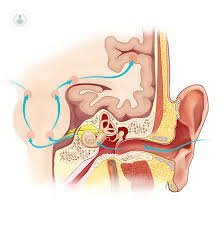Hearing loss in adults
Written by: Hearing loss is a wide pathology refers to hearing loss. Its origin can be different. Its origin can be different, and according to it, proceed to one treatment or another to prevent progression and maintaining quality patient hearing. Many cases of hearing loss occur in children, and some are already present at birth, but many are diagnosed by otolaryngologist in adults, because of a problem with the internal, external or middle ear.
Hearing loss is a wide pathology refers to hearing loss. Its origin can be different. Its origin can be different, and according to it, proceed to one treatment or another to prevent progression and maintaining quality patient hearing. Many cases of hearing loss occur in children, and some are already present at birth, but many are diagnosed by otolaryngologist in adults, because of a problem with the internal, external or middle ear.
Hearing loss in adults can be classified into two groups according to the location of the problem: hearing loss and hearing loss transmission or conduction of perception.
Transmission or conduction hearing loss
Hearing loss includes transmission cases due to an alteration of the outer ear, which is the entrance or ear canal or middle ear, which houses the eardrum and ossicles. The main causes of this type of hearing loss are:
- Otosclerosis: progressive immobility of the stapes
- Cholesteatoma benign tumor of the middle ear
- Tympanic perforation: for various reasons such as beatings, exposure to very high frequencies of sound, tumors, ear infections, etc. may occur
- Chronic otitis media: in these cases of infection hearing loss may be resolved or improved by surgery (tympanoplasty)
What is a tympanoplasty?
Tympanoplasty is the optimal surgery to correct abnormalities of the eardrum and ossicles in the middle ear located. To an affected eardrum, it must be replaced by a graft obtained from the patient's own skin. Through this operation, the partial or total perforacón the eardrum closes without scarring.
If the problem lies in the middle ear bones, such as the hammer, anvil and stirrup, they are replaced by a prosthesis.
In any case, if the hearing loss is very important to improve patient hearing can use osseointegrated implants.
What are osseointegrated implants?
Osseointegrated implants are small devices that are implanted behind the patient's ear to enhance your listening quality to dramatically increase the absorption and transmission of sound through the bone.
They are placed mainly in:
- Patients with chronic ear drainage, since this will prevent the use of hearing aid
- Patients with narrowing of the ear canal entrance and because the hearing aid will not have enough space for placement
Perception hearing loss
Treatment of hearing loss without headphones
Hearing loss in perception the problem lies in the inner ear. The patient affected by this type of hearing loss feel that senses sound but does not understand it correctly.
Initially, treatment for this type of deafness goes through a hearing aid. But if they fail, it will be used for middle ear implants or cochlear implants.
What is a middle ear implant?
These implants consist of a small prosthesis that is surgically placed. In cases of presbycusis, which would be the aged ear, equivalent to presbyopia, the prosthesis is implanted in the ossicles. This increases mobility and sound transmission from the exterior to the auditory nerve of the patient.
What is a cochlear implant?
The cochlear implant is currently the only effective treatment that exists today for severe deafness. Hearing loss is considered severe when the patient can no longer understand the words but are using a hearing aid.
Thus, the cochlear implant is an electronic device that is placed in the inner ear through surgery, and transform sound into electrical signal, which stimulate the auditory nerve.
The operation for implantation is performed under general anesthesia lasting about 90 minutes, requiring only an overnight hospital stay.
After surgery, patients with cochlear implants will need speech therapy monitoring, to interpret auditory information that reaches them by the implant, and thus understand and use language correctly.
These implants can be placed in patients aged 6 months and 80 years old. In the elderly, the main condition is to present a correct state of health. In children this treatment is very effective, as it allows normal language development to be started early. The ideal time to start a child with cochlear implant age is 3 years old.


